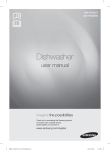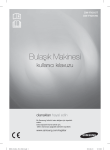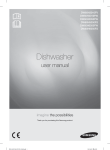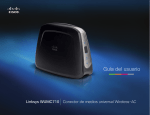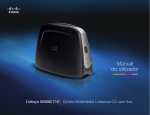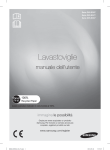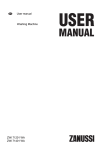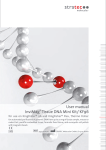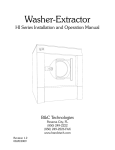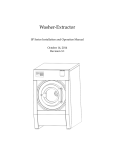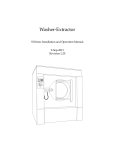Download Samsung DW-FN310T/XFA User Manual
Transcript
DW-FN310T DW-FN310W Dishwasher user manual imagine the possibilities Thank you for purchasing this Samsung product. To receive more complete service, please register your product at www.samsung.com/register DD81-01624A_EN_130905.indd 1 9/5/2013 3:11:11 PM Safety information Please read this User Information carefully and keep it to refer to at a later date. Pass it on to any subsequent owner of the appliance. This manual contains sections of Safety Instructions, Part and Features, Installation your dishwasher and Troubleshooting etc. Carefully reading it before using the dishwasher will help you to use and maintain the dishwasher properly. The manufacturer, following a policy of constant development and up-dating of the product, may make modifications without giving prior notice. WARNING: When using your dishwasher, follow the below basic precautions including the following: Proper use • Do not abuse, sit on, or stand on the door or dish rack of the dishwasher. • Do not operate your dishwasher unless all enclosure panels are properly in place. Open the door very carefully if the dishwasher is operating. There is a risk of water squirting out. • Do not place any heavy objects of stand on the door when it is open. The appliance could tip forward. • When loading items to be washed: -- Locate sharp items so that they are not likely to damage the door seal; -- Load sharp knives with the handles up to reduce the risk of cut-type injuries; • Warning : knives and other utensils with sharp points must be loaded in the basket with their points down or placed in a horizontal position. • Check that the detergent receptacle is empty after completion of the wash cycle. • Do not wash plastic items unless they are marked dishwasher safe or the equivalent. For plastic items not so marked, check the manufacturer’s recommendations. • Use only detergent and rinse additives designed for an automatic dishwasher. Never use soap, laundry detergent, or hand washing detergent in your dishwasher. • Other means for disconnection from the supply must be incorporated in the fixed wiring with at least 3 mm contact separation in all poles. • Keep children away from detergent and rinse aid, keep children away from the open door of the dishwasher, there could still be some detergent left inside. • Young children should be supervised to ensure that they do not play with the appliance. • The appliance is not intended for use by young children or infirm persons without supervision. • Dishwasher detergents are strongly alkaline. They can be extremely dangerous if swallowed. Avoid contact with skin and eyes and keep children away from the dishwasher when the door is open. • The door should not be left in the open position since this could present a tripping hazard. • If the supply cord is damaged, it must be replaced by the manufacturer or its service agent or a similarly qualified person in order to avoid a hazard. • Please dispose of packing materials properly. • Use the dishwasher only for its intended function. • During installation, the power supply must not be excessively or dangerously bent or flattened. • Do not tamper with controls. • The appliance is to be connected to the water mains using new hose sets and the old hose-sets should not be reused. READ AND FOLLOW THIS SAFETY INFORMATION CAREFULLY SAVE THESE INSTRUCTIONS 2_ Safety information DD81-01624A_EN_130905.indd 2 9/5/2013 3:11:11 PM Disposal Dispose of the dishwasher packaging material correctly. All packaging materials can be recycled. Plastic parts are marked with the standard international abbreviations: PE PS POM PP ABS for polyethylene, e.g. sheet wrapping material for polystyrene, e.g. padding material polyoxymethylene, e.g. plastic clips polypropylene, e.g. Salt filler Acrylonitrile Butadiene Styrene, e.g. Control Panel. WARNING: Packaging material could be dangerous for children! For disposing of package and the appliance please go to a recycling centre. Therefore cut off the power supply cable and make the door closing device unusable. Cardboard packaging is manufactured from recycled paper and should be disposed in the waste paper collection for recycling. By ensuring this product is disposed of correctly, you will help prevent potential negative consequences for the environment and human health, which could otherwise be caused by inappropriate waste handling of this product. For more detailed information about recycling of this product, please contact your local city office and your household waste disposal service. Instruction about the WEEE mark Correct Disposal of This Product (Waste Electrical & Electronic Equipment) (Applicable in countries with separate collection systems) This marking on the product, accessories or literature indicates that the product and its electronic accessories (e.g. charger, headset, USB cable) should not be disposed of with other household waste at the end of their working life. To prevent possible harm to the environment or human health from uncontrolled waste disposal, please separate these items from other types of waste and recycle them responsibly to promote the sustainable reuse of material resources. Household users should contact either the retailer where they purchased this product, or their local government office, for details of where and how they can take these items for environmentally safe recycling. Business users should contact their supplier and check the terms and conditions of the purchase contract. This product and its electronic accessories should not be mixed with other commercial wastes for disposal. READ AND FOLLOW THIS SAFETY INFORMATION CAREFULLY SAVE THESE INSTRUCTIONS Safety information _3 DD81-01624A_EN_130905.indd 3 9/5/2013 3:11:11 PM Contents Part and features 5 5 Dishwasher features 6 Control panel 7Displays Installing your dishwasher 9 10 10 10 Water supply and drain Connection of drain hoses Position the appliance Start of dishwasher Using the detergent and water softener 11 12 13 15 17 Water softener Loading the salt into the softener Fill the rinse aid dispenser Function of detergent How to use the 3 in 1 option Loading the dishwasher racks 18 19 19 20 21 Loading the upper basket Loading the lower basket Folding spikes of lower basket Cutlery(silverware) basket For washing in the dishwasher the following cutlery/dishes Washing programmes 22 22 23 23 Turning on the appliance Change the program... At the end of the wash cycle Wash cycle table Cleaning and care 24 25 25 25 25 26 Cleaning the filters Cleaning the spray arms Cleaning the door Caring for the dishwasher Protect against freezing How to keep your dishwasher in shape 8 11 18 22 24 Troubleshooting 27 Appendix 30 27 Before calling for service 29 Error codes 30Specifications 30 Product dimension 4_ Contents DD81-01624A_EN_130905.indd 4 9/5/2013 3:11:11 PM Part and features Dishwasher features Front & Rear view 01 PART AND FEATURES 6 1 2 7 8 3 4 5 10 9 1 Upper Basket 4 Salt Container 7 Spray arms 2 Duct nozzle 5 Dispenser 8 Filter assembly 3 Lower Basket 6 Cup Shelf 9 Inlet water valve 10 Drain hose Accessory parts - User manual, Salt funnel, cutlery basket. Part and features _5 DD81-01624A_EN_130905.indd 5 9/5/2013 3:11:11 PM Part and features Control panel 1 5 6 7 4 3 2 8 1 POWER BUTTON Press this button to turn on your dishwasher: the screen lights up. 2 3 IN 1 OPTION BUTTON To select 3 in 1 option which needs not salt and rinse aid but a 3 In1 tablet. This option can be selected on Intensive, Eco program only. 3 DELAY START BUTTON Press this button to set the delayed hours for washing. You can delay the start of washing up to 24 hours. One press on this button delays the start of washing by one hour. 4 CHILD LOCK BUTTON This option allows you to lock the buttons on the control panel so children cannot accidentally start the dishwasher by pressing the buttons on the panel. To lock and unlock the buttons on the control panel, hold down both the 3 in 1 and Delay start buttons for three (3) seconds. 5 DISPLAY WINDOW Running indicator, delay time, error codes and etc. 6 PROGRAM BUTTON To select washing program press the button. START/PAUSE BUTTON In Power on condition, close the dishwasher door and select the cycle and desired options. Press the Start/Pause button to begin the cycle. Whenyouwanttopausethedishwasherwhilerunning,presstheStart/Pause button and make sure to open the door slowly and carefully. You can reset the machine by pressing the Start/Pause button for 3 seconds during washing. After reset, the dishwasher goes to the initial state except salt consumption setting of water softener. HALF LOAD BUTTON To select Half load function. (With this Half load function you can only use it when you have only about or less than 6 place setting dishware, and you will see less water and energy consumption. It can only be used with Intensive, Eco and Delicate.) 7 8 • When the door is open only the Power button will operate. • You can select options (3 in 1, Delay start and/or Half load) before starting a cycle. IMPORTANT: To get the best performance from your dishwasher, read all the operating instructions before using it for the first time. 6_ Part and features DD81-01624A_EN_130905.indd 6 9/5/2013 3:11:11 PM Displays 1 01 PART AND FEATURES 2 1 PROGRAM ICON When press the Program button, each program is selected. 2 3*8 SEGMENT Display the remaining time, error code, or delay time. RINSE AID INDICATOR When rinse aid is needed refill, this indicator is on. Refill the rinse aid to dispenser. 3 IN 1 ICON When select 3 in 1 option. SALT INDICATOR When salt is needed refill, this indicator is on. Refill the salt to water softener. CHILD LOCK ICON When select Child lock function. HALF LOAD ICON When select Half load option. WATER INLET INDICATOR When occur water inlet problem. Check the water faucet or water inlet hose. Part and features _7 DD81-01624A_EN_130905.indd 7 9/5/2013 3:11:12 PM Installing your dishwasher WARNING : Electrical shock hazard Disconnect electrical power before installing dishwasher. Failure to do so could result in death or electrical shock. ATTENTION: The installation of the pipes and electrical equipments should be done by professionals. About electricity connecting CAUTION, for personal safety: DO NOT USE AN EXTENSION CORD OR AN ADAPTER PLUG WITH THIS APPLIANCE. DO NOT, UNDER ANY CIRCUMSTANCES, CUT OR REMOVE THE THIRD GROUNDING PRONG FROM THE POWER CORD. Electrical requirements • An AC 220-240 V / 50 Hz fuse or a circuit breaker. • An individual branch circuit serving your dishwasher. Grounding instructions Insure proper ground exists before use This appliance must be grounded. In the event of a malfunction or breakdown, grounding will reduce the risk of electric shock by providing a path of least resistance of electric current. This appliance is equipped with a cord having an equipment-grounding conductor and a grounding plug. The plug must be plugged into an appropriate outlet that is installed and grounded in accordance with all local codes and ordinances. WARNING: Improper connection of the equipment grounding conductor can result in the risk of an electric shock. Check with a qualified electrician or service representative if you are in doubt whether the appliance is properly grounded. Do not modify the plug provided with the appliance. 8_ Installing your dishwasher DD81-01624A_EN_130905.indd 8 9/5/2013 3:11:12 PM Water supply and drain Cold water connection 02 INSTALLING Connect the cold water supply hose to a threaded 3/4 (inch) connector and make sure that it is fastened tightly in place. If the water pipes are new or have not been used for an extended period of time, let the water run to make sure that the water is clear. This precaution is needed to avoid the risk of the water inlet to be blocked and damage the appliance. Hot water connection The water supply to the appliance can also be connected to the house hot water line (centralized system, heating system), as long as it does not exceed a temperature of 60 °C. In this case, the wash cycle time will be shortened by about 15 minutes and the wash efficiency slightly reduced. The connection must be made to the hot water line following the same procedures as those for the connection to the cold water line. Positioning the appliance Position the appliance in the desired location. The back should rest against the wall behind it, and the sides, along the adjacent cabinets or wall. The dishwasher is equipped with water supply and drain hoses that can be positioned to the right or the left to facilitate proper installation. How to drain excess water from hoses If the sink is 1000 mm higher from the floor, the excess water in hoses cannot be drained directly into the sink. It will be necessary to drain excess water from hoses into a bowl or suitable container that is held outside and lower than the sink. Water outlet Connect the water drain hose. The drain hose must be correctly fitted to avoid water leaks. Ensure that the water inlet hose is not kinked or squashed. Extension hose If you need a drain hose extension, Use a similar size and quality drain hose. It must be no longer than 4 metres; otherwise the cleaning effect of the dishwasher could be reduced. Syphon connection The waste connection must be at a height of between 40 cm (minimum) and 100 cm (maximum) from the bottom of the dishwasher. The water drain hose should be fixed by a hose clip. Installing your dishwasher _9 DD81-01624A_EN_130905.indd 9 9/5/2013 3:11:12 PM Installing your dishwasher Connection of drain hoses Insert the drain hose into a drain pipe with a minimum diameter of 4 cm, or let it run into the sink, making sure to avoid bending or crimping it. The top of the hose must be at a height between 40 and 100 cm. The free end of the hose must not be immersed in water to avoid the back flow of it. Drain pipe Max 1000 mm NOTE The top of the hose must be at a height between 40 and 100cm. The free end of the hose must not be immersed in water. Min. 400 mm Counter 40 mm Position the appliance Position the appliance in the desired location. The back should rest against the wall behind it, and the sides, along the adjacent cabinets or walls. The dishwasher is equipped with water supply and drain hoses that can be positioned either to the right or the left sides to facilitate proper installation. Levelling the Appliance Once the appliance is positioned for levelling, the height of the dishwasher may be altered via adjustment of the screwing level of the feet. In any case, the appliance should not be inclined more than 2°. Start of dishwasher The followings should be checked before starting the dishwasher. 1. the dishwasher is level and fixed. 2. the inlet valve is opened. 3. there leakage at the connections of the conducts. 4. the wires are tightly connected. 5. the power is switched on. 6. the inlet and drain hoses are not knotted. 7. All packing materials and printings should be taken out from the dishwasher. ATTENTION: After installation please put this manual in a safe place. The contents of this manual can be useful to users. 10_ Installing your dishwasher DD81-01624A_EN_130905.indd 10 9/5/2013 3:11:12 PM Using the detergent and water softener Water softener Adjusting salt consumption The dishwasher is designed to allow for adjusting the amount of salt consumed based on the hardness of the water used. This is intended to Spelling - optimise - customise the level of salt consumption so that the salt consumption could be set proceed as follows: 1. Switch on the appliance; 2. Press the Start/Pause button for more than 3 seconds to start the water softener set model within 60seconds after the appliance was switched on; 3. Press the Start/Pause button to select the proper set according to your local environment, the sets will change in the following sequence: H1 H2 H3 H4 H5 H6; It is recommended that adjustments should be made in accordance with the following table. * The manufactory setting: H4 (EN 50242) 4. Wait for 5 seconds to end the set up model. WATER HARDNESS Selector Position Salt consumption (gram/cycle) Autonomy (cycles/1 kgs) 0~0.94 H1 0 / º dH º fH º Clark mmol/l 0~5 0~9 0~6 6~11 10~20 7~14 1.0~2.0 H2 20 60 12~17 21~30 15~21 2.1~3.0 H3 30 50 18~22 31~40 22~28 3.1~4.0 H4 40 40 23~34 41~60 29~42 4.1~6.0 H5 50 30 35~55 61~98 43~69 6.1~9.8 H6 60 20 03 DETERGENT AND WATER SOFTENER The water softener must be set manually, using the water hardness dial. The water softener is designed to remove minerals and salts from the water, which would have a detrimental or adverse effect on the operation of the appliance. The higher the content of these minerals and salts, the harder your water is. The softener should be adjusted according to the hardness of the water in your area. Your local Water Authority can advise you on the hardness of the water in your area. 1 dH (German degree) = 0.178 mmol/l 1 Clark (British degree) = 0.143 mmol/l 1 fH (French degree) = 0.1 mmol/l Contact your local water board for information on the hardness of your water supply. WATER SOFTENER The hardness of the water varies from place to place. If hard water is used in the dishwasher, deposits may form on dishes and utensils. The appliance is equipped with a special softener that uses a salt specifically designed to eliminate lime and minerals from the water. Using the detergent and water softener _11 DD81-01624A_EN_130905.indd 11 9/5/2013 3:11:12 PM Using the detergent and water softener Loading the salt into the softener Always use salt intended for use with dishwasher. The salt container is located beneath the lower rack and should be filled as follows: ATTENTION • Only use salt specifically designed for use in dishwashers! All other types of salt not specifically designed for use in a dishwasher, especially table salt, will damage the water softener. In case of damages caused by the use of unsuitable salt the manufacturer does not give any warranty nor is liable for any caused damages. • Only fill with salt just before starting one of the complete washing programs. This will prevent any grains of salt or salty water, which may have been split, remaining of the bottom of the machine for any period of time, which may cause corrosion. • After the first wash cycle the control panel light expires. 1. Remove the lower basket and then unscrew and remove the cap from the salt container. Open 2. If you are filling the container for the first time, fill 2/3 of its volume with water (around 1 liter). 3. Place the end of the funnel (supplied) into the hole and introduce about 1,5 kg of salt. It is Normal for a small amount of water to come out of the salt container. 4. Carefully screw the cap back on. 5. Usually, the salt warning light will be off after the salt container be filled with salt. • The salt container must be refilled when the salt warning light in the control panel comes on. Though the salt container is filled enough, the indicator light may not light may not switch off until the salt fully dissolves. If there is no salt warning light in the control panel, you can judge when to load the salt into the softener by the cycles that the dishwasher has run. • If a lot of salt is spilt inside the dishwasher run a pre wash program to clan the spillage. 12_ Using the detergent and water softener DD81-01624A_EN_130905.indd 12 9/5/2013 3:11:13 PM Fill the rinse aid dispenser Function of rinse aid ATTENTION: Only use branded rinse aid for dishwasher. Never fill the rinse aid dispenser with any other substances (e.g. dishwasher cleaning agent, liquid detergent). This would damage the appliance. When to refill the rinse aid dispenser If there is no rinse-aid warning light in the control panel, you can judge the amount of rinse-aid by the Colour of the optical level indicator “D” located next to the cap. When the rinse-aid container is full, the whole indicator will be dark. As the rinse-aid diminishes, the size of the dark dot decreases. You should never let the rinse aid get below 1/4 full. As the rinse aid diminishes, the size of the black dot on the rinse aid level indicator changes, as illustrated below. Full 3/4 full 1/2 full 1/4 full : Should refill to eliminate spotting Empty 03 DETERGENT AND WATER SOFTENER Rinse aid is automatically added during the last rinse, ensuring thorough rinsing, and spot and streak free drying. D (Rinse-Aid indicator) Using the detergent and water softener _13 DD81-01624A_EN_130905.indd 13 9/5/2013 3:11:13 PM Using the detergent and water softener Rinse Aid dispenser 1. To open the dispenser, turn the cap to the “open” (left) arrow and lift it out. 2. Pour the rinse aid into the dispenser, being careful not to overfill. 3. Replace the cap by inserting it aligned with “open” arrow and turning it to the closed (right) arrow. The rinse aid is released during the final rinse to prevent water from forming droplets on your dishes that can leave spots and streaks. It also improves drying by allowing water to water to run off the dishes. Your dishwashers is designed to use liquid rinse aids. The rinse aid dispenser is located inside the door next to the detergent dispenser. To fill the dispenser, open the cap and pour the rinse aid into the dispenser until the level indicator turns completely black. The volume of the rinse aid container is about 130 ml. Be careful not to overfill the dispenser, because this could cause over sudsing. Wipe away any spills with a damp cloth. Don’t forget to replace the cap before you close dishwasher door. ATTENTION: Clean up any rinse aid spilt during filling with an absorbent cloth to avoid excess foaming during the next wash. Adjusting rinse aid dispenser The rinse aid dispenser has four settings. Always start with the dispenser set on “3”. If spots and poor drying are problems, increase the amount of rinse aid dispensed by removing the dispenser lid and rotating the dial to “4”. We suggest you to set on “3” (Factory value is “3”). Increase the dose if there are drops of water or lime spots on the dishes after washing. Reduce it if there are sticky whitish streaks on the dishes or a bluish film on glassware or knife blades. 14_ Using the detergent and water softener DD81-01624A_EN_130905.indd 14 9/5/2013 3:11:13 PM Function of detergent Detergents with its chemical ingredients are necessary to remove dirt, crush dirt and transport it out of the dishwasher. Most of commercial quality detergents are suitable for this purpose. WARNING: Dishwasher detergent is corrosive! Take care to keep it out of reach of children. Concentrated detergent Based on their chemical composition, dishwasher detergent can be split in two basic types: • conventional, alkaline detergents with caustic components • low alkaline concentrated detergents with natural enzymes The use of “normal” washing programmes in conjunction with concentrated detergents reduces pollution and is good for your dishes; these wash programmes are specially matched to the dirt-dissolving properties of the enzymes of the concentrated detergent. For this reason “normal” wash programmes in which concentrated detergents are used can achieve the same results that can otherwise only be achieved using “intensive” programmes. Detergent tablets Detergent tablets of different brands dissolve at different speeds. For this reason some detergent tablets cannot dissolve and develop their full cleaning power during short programmes. Therefore please use long programmes when using detergent tablets, to unsure the complete removal of detergent residuals. 03 DETERGENT AND WATER SOFTENER Proper Use of Detergent Use only detergent specifically made for use in dishwashers. Keep your detergent fresh and dry. Don’t put powder detergent into the dispenser until you’re ready to wash dishes. Detergent dispenser The dispenser must be refilled before the start of each wash cycle following the instructions provided in the Wash Cycle Table. Your dishwasher uses less detergent and rinse aid then conventional dishwashers. Generally, only one tablespoon of detergent is needed for a normal wash load. Also, more heavily soiled items need more detergent. Always add the detergent just before starting the dishwasher, otherwise it could get damp and will not dissolve properly. Fill the detergent in dispenser 1. If the lid is closed: press release button. The lid springs open. Push latch to open 2. Always add the detergent just before starting each wash cycle. Only use branded detergent aid for dishwasher. Using the detergent and water softener _15 DD81-01624A_EN_130905.indd 15 9/5/2013 3:11:13 PM Using the detergent and water softener Amount of detergent to use 1. Fill the detergent dispenser with detergent. The marking indicates the dosing levels, as illustrated on right: A. This section is for main wash detergent, approximately 25 g B. This section is for the pre wash detergent, approximately 5 g If the dishes are heavily soiled, place an additional detergent dose in the pre-wash detergent chamber. This detergent will take effect during the pre-wash phase. You can find information about the amount of detergent for the single programmes on the “Wash cycle table”. (See page 23) Please be aware, that according to the soiling level and the specific hardness of water differences are possible. A B 2. Close the lid and press until it locks in place. Please observe the manufacturers dosing and storage recommendations as stated on the detergent packaging. Detergents There are 3 sorts of detergents. 1. With phosphate and with chlorine. 2. With phosphate and without chlorine. 3. Without phosphate and without chloride. Normally new pulverised detergent is without phosphate. The water softener function of phosphate is not given. In this case we recommend to fill salt in the salt container even when the hardness of water is only 6 dH. If detergents without phosphate were used in case of hard water often white spots appear at dishes and glasses. In this case please add more detergent to reach better results. Detergents without chlorine do only bleach a little. Strong and coloured spots will not removed completely. In this case please choose a programme with higher temperature. 16_ Using the detergent and water softener DD81-01624A_EN_130905.indd 16 9/5/2013 3:11:13 PM How to use the 3 in 1 option Your dishwasher has a 3 in 1 option which does not need salt and rinse aid but a 3 In1 tablet. This option can select on Intensive, Eco program only. 03 DETERGENT AND WATER SOFTENER The 3 in 1 setting is only for use with 3 in 1 tablets. If using 3 in 1 tablet without this option, the appliance will not get it’s best performance. 1. Put the 3 in 1 tablet into the container then start the 3 in 1 option. 2. Close the lid and press until it locks in place. When using 3 in 1 compact combination detergents ensure that the lid can be closed correctly. ATTENTION: Keep all detergents in a safe place out of children’s reach. Always add the detergent in the dispenser just before starting the dishwasher. Using the detergent and water softener _17 DD81-01624A_EN_130905.indd 17 9/5/2013 3:11:14 PM Loading the dishwasher racks For best performance of the dishwasher, follow these loading guidelines. Features and appearance of racks and silverware baskets may vary from your model. Attention before or after loading the dishwasher racks Scrape off any large amounts of leftover food. It is not necessary to rinse the dishes under running water. Place objects in the dishwasher in the following order: 1. Items such as cups, glasses, pots/pans, etc. are stood upside down. 2. Curved items, or those with recesses, should be at a slant so that water can run off. 3. They are stacked securely and can not tip over. 4. They do not prevent the spray arms from rotating while washing takes place. Very small items should not be washed in the dishwasher as they could easily fall out of the racks. Removing the dishes To prevent water dripping from the upper basket into the lower basket, we recommend that you empty the lower basket first and then the upper basket. 1 2 Loading the upper basket 1 The upper basket is designed to hold more delicate and lighter dishware such as glasses, coffee2and tea 1 shallow pans (as long as they are not too dirty). cups and saucers, as well as plates, small bowls and 3 Position the dishes and cookware so that they will 2 not get moved by the spray 1 of water. Always place glasses, cups & bowls upside down. 1 IN 3 1 4 5 6 2 3 3 1 3 Cups 3 1 2 Saucers 4 1 3 5 4 bowl Medium serving 2 4 3 3 5 4 Glasses 4 6 5 Large serving bowl Small serving bowl 5 6 Adjusting the Upper Basket6 7 6 5 The height of the upper basket can be adjusted in order to create more space for large utensils 7 both for the upper/lower basket. The height of the upper basket can be 7 adjusted by placing the wheels on different height of the rails. Long items, serving 6 cutlery, salad servers and knives should be placed on the shelf so that they do not obstruct the rotation of the spray arms. 8 Caution: We recommend adjusting 7 the height of the upper basket before loading dishes into the basket. If you adjust the the basket after loading 9the dishes, you may damage the dishes. 8 18_ Loading the dishwasher racks DD81-01624A_EN_130905.indd 18 10 9 8 7 9 8 10 9 To lower position 8 9 To upper10 position 10 9/5/2013 3:11:18 PM 2 1 2 3 3 4 4 5 Loading the lower basket 3 4 4 5 5 6 IN 7 8 7 8 8 9 Dessert dishes Dinner plates 8 9 9 10 Soup plates Oval platter 9 IN 04 LOADING THE RACKS We recommend that you place large items which 5 are most difficult 6to clean in to the lower rack: pots, pans, lids, serving dishes and bowls, as shown in the figure to the right. 6 7 It is preferable to place serving dishes and lids on the side of the racks in order to avoid blocking the rotation of the top spray arm. Pots, serving bowls, etc. must always be placed top down. Deep pots should be slanted to allow water to6flow out. 7 The bottom rack feature fold down tine rows so that larger or more pots and pans can be loaded. 10 10and big knives should be placed on the shelf so that they do Long items, serving cutlery, salad servers not obstruct the rotation of the spray arms. 10 Folding spikes of lower basket For better stacking of pots and pans, the spikes can be folded down as show in the picture right. Loading the dishwasher racks _19 DD81-01624A_EN_130905.indd 19 9/5/2013 3:11:24 PM Loading the dishwasher racks Cutlery(silverware) basket Silverware should be placed in the cutlery basket with handles at the bottom: The spoon should be loaded individually into the appropriate slots, especially long utensils should be placed in the horizontal position at the front of the upper basket. 1 Soup spoons 5 Dessert spoons 2 Forks 6 Serving spoons 3 Knives 7 Serving forks 4 Teaspoons 8 Gravy ladles WARNING • Do not let any item extend through the bottom. • Always load sharp utensils with the sharp point down! 20_ Loading the dishwasher racks DD81-01624A_EN_130905.indd 20 9/5/2013 3:11:25 PM For washing in the dishwasher the following cutlery/ dishes Are of limited suitability Cutlery with wooden, horn china or mother-of-pearl handles. Plastic items that are not heat resistant Older cutlery with glued parts that is not temperature resistant Bonded cutlery items or dishes Pewter or cooper items Lead crystal glass Steel items subject to rusting Wooden platters Items made from synthetic fibres. Some types of glasses can become dull after a large number of washes. Silver and aluminium parts have a tendency to discolour during washing. Glazed patterns may fade if machine washed frequently. 04 LOADING THE RACKS Are not suitable Do not try and wash items soiled with cigarette ash, candle wax, lacquer or paint. If you buy new dishes please make sure that they are suitable for dishwashers. Please do not overload your dishwasher. There is only space for 12 standard dishes. Do not use dish that are not suitable for dishwashers. This is important for good results and for reasonable energy consumption. When loading the dishes and cutlery Dishes and cutlery must not impede the rotation of the spray arms. Load hollow items such as cups, glasses, pans etc. with the opening downwards so that water cannot collect in the container or a deep base. Dishes and items of cutlery must not lie inside one another, or cover each other • To avoid damage to glasses, they must not touch. • Load large items which are most difficult to clean into the lower rack. • The upper rack is designed to hold more delicate and lighter dishware such as glasses, coffee and tea cups. ATTENTION Long bladed knives stored in an upright position are a potential hazard! Long and/or sharp items of cutlery such as carving knives must be positioned horizontally in the upper basket. Damage to glassware and other dishes. Possible causes Suggested remedy • Type of glass or manufacturing process. Chemical composition of detergent. • Water temperature and duration of dishwasher programme. • Use glassware or porcelain dishes that have been marked dishwasher-proof by the manufacturer • Use a mild detergent that is described as kind of dishes If necessary, seek further information from detergent manufacturers. • Select a programme with as low a temperature. • To prevent damage, take glass and cutlery out of the dishwasher as soon as possible after the programme has ended. Loading the dishwasher racks _21 DD81-01624A_EN_130905.indd 21 9/5/2013 3:11:26 PM Washing programmes Turning on the appliance Starting a cycle wash 1. Draw out the lower and upper basket, load the dishes and push them back.. It is recommended to load the lower basket first, then the upper one (see the section entitled “Loading the dishwasher racks”). 2. Pour in the detergent (see the section entitled “Using the detergent and water softener”). 3. Insert the plug into the socket. The power supply is 220-240 VAC / 50 HZ, the specification of the socket is 15A 250 VAC. Make sure that the water supply is turned on to proper pressure. 4. Close the door, press the Power button, to switch on the machine. 5. Press the Program button, the wash program will be changed as follows direction: Intensive Eco Delicate Express Wash Pre Wash If a wash program is selected, the response light will light. Then press the Start/Pause button, the dishwasher begins to start. When you press the Start/Pause button to pause during washing, the running indicator will stop blinking and the dishwasher will beep every minute unless you press the Start/Pause button to start. Change the program... Premise: 1. A cycle that is underway can only be modified if it has only been running for a short time. Otherwise, the detergent may have already been released, and the appliance may have already drained the wash water. If this is the case, the detergent dispenser must be refilled (see the section entitled “Fill the detergent in dispenser”). 2. Press the Start/Pausebutton, the machine will be in standby state, press the Program button more than 3 seconds then you can change the program to the desired cycle setting. If you open the door during a wash cycle, the machine will pause. The program light will stop blinking and the buzzer will beep every minute unless you close the door. After you close the door, the machine will keep on working after 3 seconds automatically. If your model has broken memory function, the machine will go on to finish the selected program after the power cut. Add a dish A forgotten dish can be added at any time before the detergent dispenser opens. 1. Press the Start/Pause button and make sure to open the door slowly and carefully as there is a possibility of injury from the hot steam inside the dishwasher. 2. After the spray arms stop working, you can open the door completely. 3. Add forgotten dishes. 4. Close the door. The dishwasher will work after 3 seconds. WARNING: It is dangerous to open the door when washing, because the hot water may scald you. If the door is opened while the dishwasher is running, a safety mechanism is activated and stops the cycle. 22_ Washing programmes DD81-01624A_EN_130905.indd 22 9/5/2013 3:11:26 PM At the end of the wash cycle Open the door carefully. Hot steam may escape when the door is opened! • Hot dishes are sensitive to knocks. The dishes should be allowed to cool down around 15 minutes before removing from the appliance. • Open the dishwasher’s door, leave it ajar and wait a few minutes before removing the dishes. In this way they will be cooler and the drying will be improved. • Unloading the dishwasher. It is normal that the dishwasher is wet inside. Empty the lower basket first and then the upper one. This will avoid water dripping from the upper basket onto the dishes in the lower one. 05 WASHING PROGRAMMES When the working cycle has finished, the buzzer of dishwasher will beep shortly, then stop. In the digital display appears “End”, only in this case the programme has ended. 1. Switch off the dishwasher by pressing the Power button. 2. Turn off the water tap! Wash cycle table Program Intensive Eco (*EN 50242) Delicate Express Wash Pre Wash Cycle Description of Cycle Pre Wash (50 °C) For the heaviest soiled loads, such Pre Wash as pots, pans, casserole dishes Wash (65 °C) and dishes that have been Sitting Rinse with dried food on Them for a Rinse (55 °C) while. Drying Pre Wash For lightly soiled loads, such as Wash (47 °C) plates, glasses, bowls and lightly Rinse soiled pans. Rinse (64 °C) Drying Pre Wash For normally soiled dishes or fragile Wash (40 °C) items such as glasses. Rinse (60 °C) Drying Wash (40 °C) A shorter wash for lightly soiled Rinse loads that do not need drying. Rinse (45 °C) For pre-cleaned dishes or glasses. No detergent is dispensed and no Pre Wash dry cycle is initiated. Cycle selection information Detergent pre/main Energy (Kwh) Water (ℓ) 5/25 g (or 3 in 1) 1.4 17.5 5/25 g (or 3 in 1) 1.03 12 5/25 g 0.9 14.5 20 g 0.6 10.5 - 0.1 3.8 * EN 50242: This program is the test cycle. The information for comparability test in accordance with EN 50242, as follows:; • Capacity: 12 place setting • Position of Upper Basket: to lower position • Rinse aid setting: 4 Washing programmes _23 DD81-01624A_EN_130905.indd 23 9/5/2013 3:11:26 PM Cleaning and care Cleaning the filters Filtering system For your convenience, we have placed the drain pump and filtering system within easy reach inside the tub. There are three components of the filtering system: the main filter, the coarse filter, and the fine filter. 1. Main filter: Food and soil particles trapped by this filter are pulverized by a special jet on the lower spray arm and washed down the drain. 2. Coarse filter: Larger items, such as pieces of bone or glass, that could clog the drain are trapped in the coarse filter. To remove an item caught in this filter, gently squeeze the tabs on top of this filter and lift it out. 3. Fine filter: This filter holds soil and food residue in the sump area and prevents it from being redeposited on the dishes during a cycle. 2 1 3 ATTENTION: Do not put the fine filter upside down. Filter assembly For best performance and results, the filter assembly must be cleaned. The filter efficiently removes food particles from the wash water, allowing it to be recirculated during the cycle. For this reason, it is a good idea to remove the larger food particles trapped in the filter after each wash cycle by rinsing the semicircular filter and cup under running water. To remove the filter assembly, turn it in anti-clockwise direction and lift the filter assembly up. The entire filter assembly should be cleaned regularly. To clean the coarse filter and the fine filter, use a cleaning brush. Then, reinsert the entire assembly in the dishwasher, positioning in its seat, pressing downward, turning it clockwise direction. Open The dishwasher must never be used without the filters. Improper replacement of the filter may reduce the performance level of the appliance and damage dishes and utensils. WARNING: Never run the dishwasher without the filters in place. When cleaning the filters, do not damage them. Otherwise the filters may not perform as intended and poor wash results or damage to the internal parts may be encountered. 24_ Cleaning and care DD81-01624A_EN_130905.indd 24 9/5/2013 3:11:26 PM Cleaning the spray arms Open Cleaning the door 06 CLEANING AND CARE It is necessary to clean the spray arms regularly as hard water chemicals may clog the spray arm jets and bearings. To remove the middle spray arm, hold the nut, rotate the arm clockwise to remove it. To remove the lower spray arm, pull out the spray arm upward. Wash the arms in soapy and warm water and use a soft brush to clean the jets. Replace them after rinsing them thoroughly. To clean the edge around the door, you should use only a soft warm, damp rag. To prevent penetration of water into the door lock and electrical components, do not use a spray cleaner of any kind. Also, never use abrasive cleaners or scouring pads on the outer surfaces because they will scratch the finish. Some papers towels can also scratch or leave marks on the surface. WARNING: Never use a spray cleaner to clvean the door panel for it could damage the door lock and electrical components. It is not advised to use the abrasive agent or some paper towel because of the risk of scratching or leaving spots on the stainless steel surface. Caring for the dishwasher To clean the control panel use a lightly damp cloth then dry thoroughly. To clean the exterior use a good appliance polish wax. Never use sharp objects, scouring pads or harsh cleaners on any part of the dishwasher. Protect against freezing If your dishwasher is left in an unheated place during the winter: 1. Cut off electrical power to the dishwasher. 2. Turn off the water supply and disconnect the water inlet pipe from the water valve. 3. Drain water from the inlet pipe and water valve. (Use a pan to catch the water) 4. Reconnect the water inlet pipe to the water valve. 5. Remove the filter in the tub the bottom and use a sponge to use up water in sump. Cleaning and care _25 DD81-01624A_EN_130905.indd 25 9/5/2013 3:11:26 PM Cleaning and care How to keep your dishwasher in shape • After Every Wash After every wash, turn off the water supply to the appliance and leave the door slightly ajar so that moisture and odours not trapped inside. • Remove the Plug Before cleaning or performing maintenance, always remove the plug from the socket. • No Solvents or Abrasive cleaning To clean the exterior and rubber parts of the dishwasher, do not use solvents or abrasive cleaning products. use only a cloth and warm soapy water. To remove spots or stains from the surface of the interior, use a cloth dampened with water and a little white vinegar, or a cleaning product made specifically for dishwashers. • When You Go on Holiday When you go on holiday, it is recommened that you run a wash cycle with the dishwasher empty and then remove the plug from the socket, turn off the water supply and leave the door of the appliance slightly ajar. This will help the seals last longer and prevent odours from forming within the appliance. • Moving the Appliance If the appliance must be moved, try to keep it in the vertical position. If absolutely necessary, it can be positioned on its back. • Seals One of the factors that cause odours to form in the dishwasher is food that remains trapped in the seals. Periodic cleaning with a damp sponge will prevent this from occurring. 26_ Cleaning and care DD81-01624A_EN_130905.indd 26 9/5/2013 3:11:26 PM Troubleshooting The manufacturer, following a policy of constant development and up-dating of the product, may make modifications without giving prior notice. Before calling for service POSSIBLE CAUSE WHAT TO DO • Fuse blown or the circuit breaker acted. • Replace fuse or reset circuit breaker. Remove any other appliances sharing the same circuit with the dishwasher. • Power supply is not turned on. • Make sure the dishwasher is turned on and the door is closed securely. Make sure the power cord is properly plugged into the wall socket. • Water pressure is low. • Check that the water supply is connected properly and the water is turned on. Drain pump doesn’t stop • Overflow. • The system is designed to detect an overflow. When it does, it shuts off the circulation pump and turns on the drain pump. Noise • Some audible sounds are normal. • Sound from soft food shredding action and detergent cup opening. • Utensils are not secure in the baskets or something small has dropped into the basket. • To ensure everything is secured in the dishwasher. • Motor hums. • Dishwasher has not been used regularly. If you do not use it often, remember to set it to fill and pump out every week, which will help keep the seal moist. • Improper detergent. • Use only the special dishwasher detergent to avoid suds. • If this occurs, open the dishwasher and let suds evaporate. • Add 1 gallon of cold water to the tub. Close and latch the dishwasher, then Start the “soak” wash cycle to drain out the water. Repeat if necessary. • Spilled rinse agent. • Always wipe up rinse agent spills immediately. Stained tub interior • Detergent with colorant was used. • Make sure that the detergent is the one without colorant. Dishes are not dried • Rinse agent dispenser is empty. • Make sure that the rinse agent dispense is filled. Dishes and flatware not clean • Improper program. • Select a more intensive wash program. • Improper rack loading. • Make sure that the action of the detergent dispenser and spray arms are not blocked by large dishware. Dishwasher doesn’t run Suds in the tub 07 TROUBLESHOOTING PROBLEM Troubleshooting _27 DD81-01624A_EN_130905.indd 27 9/5/2013 3:11:26 PM Troubleshooting PROBLEM POSSIBLE CAUSE WHAT TO DO Spots and filming on glasses and flatware 1. Extremely hard water. 2. Low inlet temperature. 3. Overloading the dishwasher. 4. Improper loading. 5. Old or damp powder detergent. 6. Empty rinse agent dispenser. 7. Incorrect dosage of detergent. To remove spots from glassware: 1. Take out all metal utensils out of the dishwasher. 2. Do not add detergent. 3. Choose the longest cycle. 4. Start the dishwasher and allow it to run for about 18 to 22 minutes, then it will be in the main wash. 5. Open the door to pour 2 cups of white vinegar into the bottom of the dishwasher. 6. Close the door and let the dishwasher complete the cycle. If the vinegar does not work: Repeat as above, except use 1/4 cup (60 ml) of citric acid crystals instead of vinegar. Cloudiness on glassware • Combination of soft water and too much detergent. • Use less detergent if you have soft water and select a shortest cycle to wash the glassware and to get them clean. Yellow or brown film on • Tea or coffee stains. inside surfaces • Using a solution of 1/2 cup of bleach and 3 cups warm water to remove the stains by hand. WARNING: You have to wait for 20 minutes after a cycle to let the heating elements cool down before cleaning interior; Failing to follow this instruct may result in the risk of burns. • Iron deposits in water can cause an overall film. • You have to call a water softener company for a special filter. • Hard water minerals. • To clean the interior, use a damp sponge with dishwasher detergent and wear rubber gloves. Never use any other cleaner than dishwasher detergent for the risk of foaming or suds. Detergent cup lid won’t • Dial is not in the OFF latch position. • Turn the Dial to OFF position and slide the door latch to the left. White film on inside surface Detergent left in dispenser cups • Dishes block detergent cups. • Re-loading the dishes properly. Steam • Normal phenomenon. • There is some steam coming through the vent by the door latch during drying and water draining. Black or gray marks on dishes • Aluminum utensils have rubbed against dishes. • Use a mild abrasive cleaner to eliminate those marks. Water standing in the bottom of the tub • This is normal. • A small amount of clean water around the outlet on the tub bottom keeps the water seal lubricated. 28_ Troubleshooting DD81-01624A_EN_130905.indd 28 9/5/2013 3:11:26 PM PROBLEM Dishwasher leaks WHAT TO DO • Overfill dispenser or rinse aid spills. • Be careful not to overfill the rinse aid dispenser. Spilled rinse aid could cause overusing and lead to overflowing. Wipe away any spills with a damp cloth. • Dishwasher isn’t level. • Make sure the dishwasher is level. • Door is open. • When door is opened, buttons are not working except Power button. Close the door and press the button. • Child lock function is selected. • When selected Child lock function, buttons are not responded. To unlock this function, hold down both the 3 in 1 and Delay start buttons for three (3) seconds. Also, Child lock function is released when power cord is reconnected. 07 TROUBLESHOOTING Buttons are not working on power on state POSSIBLE CAUSE The result of washing performance may be caused by a power supply issue. Try another program before contacting for service. Error codes If an error occurs an error code may be displayed to inform you: CODES MEANING Water supply error • Longer water inlet time 1. Faucets is closed or water intake is restricted. 2. Water pressure is too low. 3. Water inlet valve or Flow-meter is not working. 4. Drain-pump is not working. (Water pressure SW detect high level. so, can not fill any more water.) Heater error • Longer heating time, but not reaching required temperature. 1. Heater or temperature sensor is breakdown. 2. Water in Tub is too low on Heater operation step. 3. Low level Protect device is not working. Leakage error • Leakage sensor detect any leakage water Overfilled into the dishwasher. Leak from somewhere to bottom tray. Failure of temperature sensor Short/Open circuit or break of temperature sensor. 4E HE LE tE POSSIBLE CAUSES WARNING: If overflow occurs, turn off the main water supply before calling a service. If there is water in the base pan because of an over fill or small leak, the water should be removed before restarting the dishwasher. Troubleshooting _29 DD81-01624A_EN_130905.indd 29 9/5/2013 3:11:26 PM Appendix Specifications Model DW-FN310T, DW-FN310W Type Freestanding Dishwasher Wash capacity 12 place setting Power 220 - 240 V / 50 Hz AC only Water pressure 0.04 ~ 1.0 MPa Rated power usage 1760-2100 W Hot water connection Max 60 °C Dry type Condensed dry system Wash type Rotating nozzle spray Dimensions 598 x 600 x 845 mm (Width×Depth×Height) Weight Unpacked 47 kg Product dimension 598 600 845 1175 30_ Appendix DD81-01624A_EN_130905.indd 30 9/5/2013 3:11:27 PM For standard test The information for comparability test in accordance with EN 50242, as follows: The diagrams below show the proper way to load the baskets based on the European Standards(EN50242). 1 • Washing capacity: 12 place settings • Test standard: EN50242/IEC60436 2 • Position of upper basket: to lower position 1 • Wash cycle : Eco 2 1 • Additional options: None 3 • Rinse aid setting: 4 2 • Water softener setting : H4 1 • Dosage of the standard detergent : pre/wash 51g + main/wash3 425 g 2 figures • For the arrangement of the items, refer below 3 2 <Upper basket> 1 IN 3 1 4 5 6 2 3 3 3 4 1 3 3 1 5 3 5 4 3 4 Glasses Small serving bowl 5 4 6 6 5 7 Large 7 serving bowl 7 6 5 7 8 9 8 7 Soup plates 9 2 6 6 8 7 6 8 1 3 1 Cups Dessert dishes <Silverware basket> 2 3 4 bowl Medium serving IN 1 2 4 5 3 6 5 <Lower basket> 2 4 5 4 2 5 Saucers 4 1 1 10 9 Soup8spoons 10 Forks Knives 10 Teaspoons 9 6 7 6 7 8 9 Dinner plates IN 8 7 8 9 10 Oval platter 9 8 9 10 10 95 Dessert spoons 6 Serving spoons 7 Serving forks 108 Gravy ladles 10 10 For standard test _31 DD81-01624A_EN_130905.indd 31 9/5/2013 3:11:34 PM Product fiche REGULATION (EU) No 1059/2010 Supplier SAMSUNG DW-FN310T DW-FN310W Model name Rated Capacity (place setting) 12 Energy efficiency class A+ Annual energy consumption, (AE c) (kWh/year) 1) 291 Standard cycle energy consumption, (E t) (kWh) 1.03 Power consumption in off mode, P o (W) 0.46 Power consumption in left-on mode, P l (W) 0.58 Annual water consumption, (AW c) (L/year) 3360 2) Drying efficiency class, A (most efficient) to G (least efficient) A Standard programme 3) Eco Programme time for the standard cycle, (min) 175 Duration of the left-on mode, (T l) (min) Airborne acoustical noise emissions (dBA re 1pW) Built-in Installation Unlimited 50 - Built-under Yes Free standing Yes 1) based on 280 standard cleaning cycles using cold water fill and the consumption of the low power modes. Actual energy consumption will depend on how the appliance is used. 2) based on 280 standard cleaning cycles. Actual water consumption will depend on how the appliance is used. 3) ‘Standard programme’ is the standard cleaning cycle which is suitable to clean normally soiled tableware, and that it is the most efficient programme in terms of combined energy and water consumption. 32_ Product fich DD81-01624A_EN_130905.indd 32 9/5/2013 3:11:35 PM Note DD81-01624A_EN_130905.indd 33 9/5/2013 3:11:35 PM Note DD81-01624A_EN_130905.indd 34 9/5/2013 3:11:35 PM Note DD81-01624A_EN_130905.indd 35 9/5/2013 3:11:35 PM QUESTIONS OR COMMENTS COUNTRY CALL OR VISIT US ONLINE AT SOUTH AFRICA 0860-SAMSUNG(726-7864 ) www.samsung.com Code No.: DD81-01624B_EN DD81-01624A_EN_130905.indd 36 9/5/2013 3:11:35 PM




































